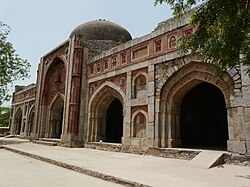| Jamali Kamali Mosque and Tomb | |
|---|---|
 Jamali Kamali Mosque | |
| Basic information | |
| Location | |
| Geographic coordinates | 28°33′45″N 77°13′4″E / 28.5625°N 77.21778°ECoordinates: 28°33′45″N 77°13′4″E / 28.5625°N 77.21778°E. [1] |
| Affiliation | Islam |
| Province | Delhi |
| Territory | Delhi |
| District | New Delhi |
| Year consecrated | Sixteenth Century |
| Ecclesiastical status | Mosque |
| Leadership | Sikander Lodi, Babar and Humayun |
| Architectural description | |
| Architect(s) | Saint Shaikh Fazlullah also known as Shaikh Jamali Kamboh |
| Architectural type | Mosque and Tomb |
| Architectural style | Religious |
| Year completed | 1528 and 1536 |
| Specifications | |
| Materials | Red Sandstone with Marble facing |
Jamali Kamali Mosque and Tomb located in the Archeological Village complex in Mehrauli, Delhi, comprise two monuments adjacent to each other, one is the mosque and the other is the tomb of two persons with the names Jamali and Kamali. Jamali (‘Jamali’ in Urdu language orginates from 'Jamal' which means “beauty”) was the pseudo name given to Shaikh Fazlu’llah, also known as Shaikh Jamali Kamboh or Jalal Khan, a renowned Sufi Saint who lived during the pre-Mughal dynasty rule of the Lodi’s (Sikander Lodi to the Mughal Dynasty rule of Babur and Humayun), and he was greatly regarded. Kamali was an unknown person but associated with Jamali and his antecedents have not been established. Their names are tagged together as "Jamali Kamali" for the mosque as well as the tomb since they are buried adjacent to each other. The mosque and the tomb building were constructed in 1528-1529 but Jamali was buried in the tomb after his death in 1535.
Mosque structure

The Jamali Kamali mosque, positioned in an enclosed garden area, built first during the years 1528-29, has a southern entry. It is built in red sandstone with marble embellishments. It is claimed to be a forerunner in the design of Mughal mosque architecture in India. The prayer hall, fronted by a large courtyard, has five arches with the central arch only having a dome. The size of arches increases towards the central arch, which is the largest of the five arches embellished with beautiful ornamentation. The spandrels of the arch are decorated with medallions and ornamentation. Fluted pilasters exquisitely decorate the central arch. The prayer wall on the west has niches with mihrab. The niches and walls are decorated with a few Koranic inscriptions. A porch around the mosque provides access to the two storied mosque and the four corners are adorned by octagonal towers. The rear end of the mosque has been provided with oriel windows, apart from a small window on the central arch.
Tomb structure

The tomb of Jamali-Kamali is an impressively decorated 7.6 m (25 ft) square structure with a flat roof, located adjacent to the mosque on its northern side. Inside the chamber, the flat ceiling is plastered and beautifully decorated. It is painted in red and blue with some Koranic inscriptions, and the walls are adorned with inlaid coloured tiles inscribed with Jamali’s poems. The decorations in the tomb have been described as “going inside is like stepping into a jewel box”. In the Jamali Kamali Mosque and Tomb the tomb chamber has two marble graves one of Jamali, the saint poet and the other of Kamali, the reason for the Kamali name could probably be that it rhymes well with Jamali.
Jamali, the poet
Jamali, who belonged to a Sunni merchant family, was indoctrinated to Sufism by Sheik Samauddin. He was a popular poet who traveled widely around Asia and the Middle East. He became court poet during Lodi Dynasty rule and continued to enjoy the patronage of the Mughal rulers, Babur and his son Humayun; it is said that his tomb was completed during Humayun’s rule. His poetry mirrored Persian mysticism of the times. His two popular works are “The Sun and Moon" and "The Spiritual Journey of the Mystics”.
Conservation
The monument is well maintained and provides a very serene atmosphere.Conservation of the monuments has been undertaken by the Archeological Survey of India (ASI) to further spruce it up before the 2010 Commonwealth Games to be held in Delhi. It is one of the 172 monuments under the jurisdiction of the Delhi Archeological circle, of ASI, identified for restoration. An amount of Rs. 15 lakhs (US$30,000) has been proposed for this purpose.
Friday prayers
It is a government order that in protected Islamic monuments assembly of people for Friday prayers is not allowed. But recent trend noted and widely reported is that of forcible congregation of Muslims at some of the historic monuments to offer prayers as in the reported case at the Jamali Kamlai Mosuqe, Qutub Minar mosque and a few others.
Access
Mehrauli urban village where the monument is located is approachable from all parts of Delhi by well laid out roads and transport system. The Indira Gandhi International Airport is 18 km away and the New Delhi Railway Station and Nizamuddin Railway Station are respectively 17 km (11 mi), and 16 km (9.9 mi) away. Visitors are free to visit the monument on all week days.
Gallery
| A grave under a pillared pavillion, chhatri, courtyard of Jamali Kamali mosque. |











0 Comments:
Post a Comment